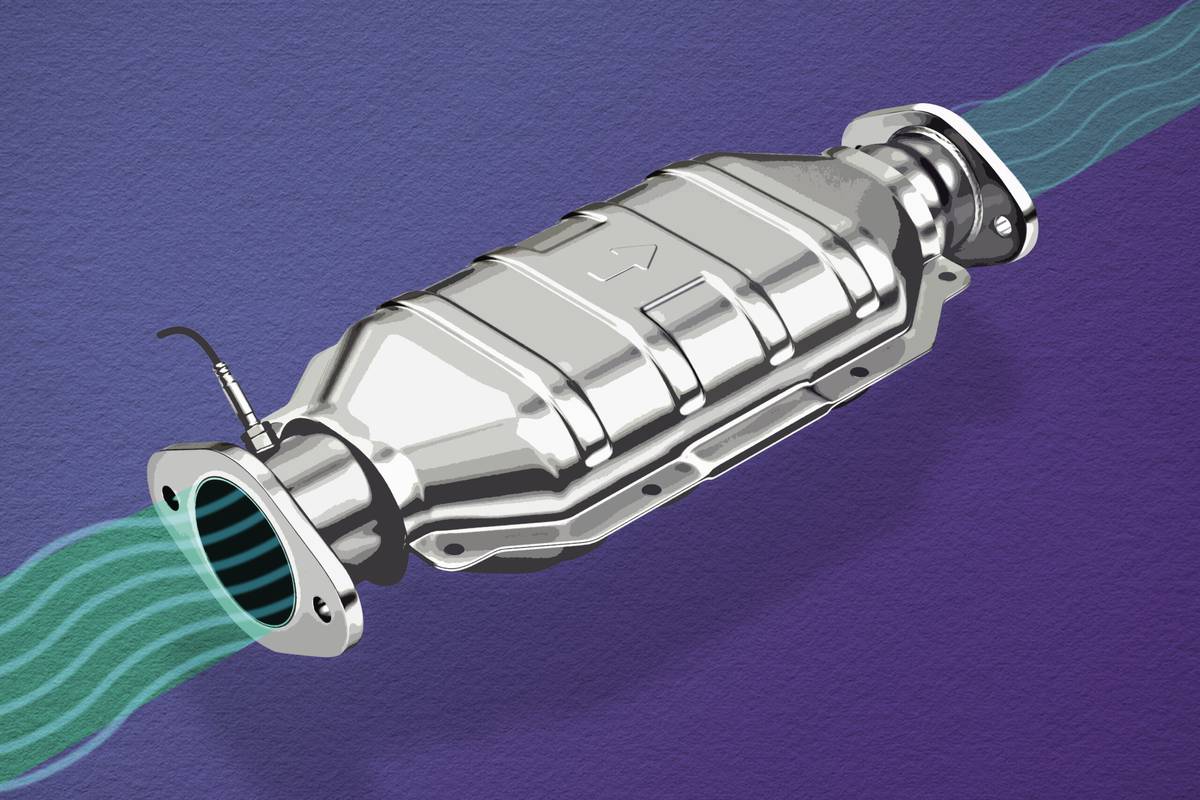What Are Common Catalytic Converter Problems?

Problems with your vehicle’s catalytic converter might first become apparent through poor acceleration, a rotten-egg smell from the exhaust, or the check-engine light coming on. As things get worse, it might even cause the engine to shut off after running a short time — or even not start at all. Most problems stem from one or more of four causes, which are discussed in greater detail below.
Related: What’s a Catalytic Converter and Why Do People Steal Them?
Causes of Catalytic Converter Problems
Physical Damage
The catalytic converter (or converters, as some vehicles may have more than one) sits underneath the car between the engine and muffler, typically under the front seats or footwells. That makes it vulnerable to being damaged if you drive over a curb or road debris, which can also damage the muffler or tailpipe. However, the damage might only be seen when the car is up on a lift, as for an oil change. (In addition, the sheet-metal heat shield encasing the converter can get loose and rattle, but that’s not really a problem with the converter itself.)
Crushing the catalytic converter will damage it, but even crushing the muffler or tailpipe can cause indirect damage to the converter, as it will increase exhaust back pressure and raise the temperature inside the converter.
Overheating
A catalytic converter’s job is to convert pollutants such as unburned gasoline and nitrogen oxide into harmless gasses. But if the converter is fed too much unburned gasoline, for instance, it will overheat, which essentially melts the inside of it. An exhaust restriction, such as from a clogged or damaged muffler, can do the same. Either issue can result in the outside of the catalytic converter getting very hot, which in a worst-case scenario can cause the interior carpet above it or the grass below it to catch fire.
Clog or Contamination
The inside of a catalytic converter can become contaminated by unburned gasoline — often due to an engine misfire, clogged air filter or bad oxygen sensor — or coolant that has likely leaked into the exhaust through a bad head gasket, or engine oil that has leaked past the piston rings or valve guides and is burned along with the air-fuel mixture in the cylinder.
Engine misfires due to a fuel problem or bad spark plugs will typically cause the check-engine light to come on, and the trouble can usually be narrowed down by running a diagnostic test. However, that test typically won’t uncover mechanical problems such as a bad head gasket, worn piston rings or valve guides.
Contamination from coolant leaking into the exhaust will usually cause white exhaust smoke, while burning oil will usually cause blue or gray exhaust smoke. (A rich fuel mixture, which indicates too much gasoline in the system, will cause black exhaust smoke.) As exhaust smoke is typically more pronounced when the car is being driven than when it’s idling, a driver may not notice it until things get really bad. Periodically checking the exhaust after the engine warms up can be helpful. Note that in cold weather, the exhaust will often be white for a short time as water that has condensed in the system gets burned off.
Whatever the cause, the check-engine light will often come on, but since the engine still seems to be running all right, people tend to ignore it. That’s not a good idea; some problems that activate the light can be fairly minor (such as not tightening the gas cap enough after a fill-up), but others (like bad spark plugs) can be things that could be inexpensively fixed now but may cause far more expensive problems down the road — including ruining the catalytic converter.
Age or Mileage
If nothing else kills them earlier, catalytic converters can easily last 10 years or more, but they’ll eventually just go bad.
More From Cars.com:
- Catalytic Converter: What You Need to Know
- Why Does My Car Smell Like Rotten Eggs?
- When Should the Oxygen Sensor Be Replaced?
- How Often Should I Replace My Catalytic Converter?
- More Service News
The Bottom Line
Partly due to a rise in thefts stemming from the increased price of the reclaimable precious metals inside, catalytic converters have not only become very expensive, they also can be hard to get. Making yours last as long as possible is worth some effort.
Aside from just dying of old age, the problems that cause catalytic converters to fail are often visually noticeable: an illuminated check-engine light, exhaust smoke or crushed exhaust system parts. Ideally, these issues should get corrected before you notice reduced engine power or a rotten-egg smell — by then, it may be too late.
Related Video:
Cars.com’s Editorial department is your source for automotive news and reviews. In line with Cars.com’s long-standing ethics policy, editors and reviewers don’t accept gifts or free trips from automakers. The Editorial department is independent of Cars.com’s advertising, sales and sponsored content departments.
Featured stories




